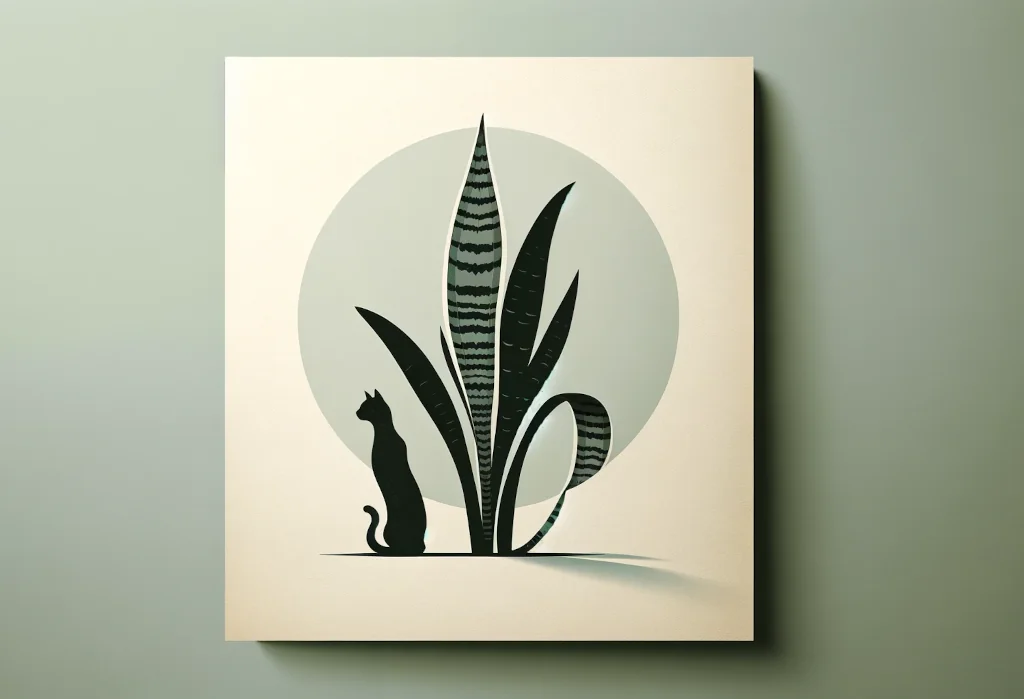We’ve all been there – your furry friend decides your latest houseplant is their new snack. Cue the heart-pounding panic as you rush to Google whether “Fido” is in dire peril.
Worry not — this blog post will guide you through the ins and outs of snake plants and their impact on your purring pals; ensuring peace of mind for the green-thumbed cat lovers among us.
Key takeaways:
- Snake plants are toxic to cats due to saponins, causing symptoms like drooling, vomiting, and lethargy.
- If your cat chews on a snake plant, remove plant material from their mouth and monitor closely for adverse symptoms.
- To keep both pets and plants safe, consider pet-friendly houseplant alternatives or use creative barriers and cat-friendly spaces.
Are Snake Plants Really Toxic to Cats?
If you’re a cat parent with a green thumb, you might be wondering about the safety of your indoor jungle, particularly when it comes to snake plants. Well, let’s cut right to the chase: yes, snake plants (also known as Sansevieria or Mother-in-Law’s Tongue) are toxic to cats.
The culprit behind this toxicity is a group of natural chemicals called saponins. While saponins are great for the plant, acting as a natural insecticide and fungicide, they’re not so great for our feline friends.
When a curious kitty chews on a snake plant, the saponins can cause irritation to the mouth, throat, and possibly the digestive tract. But don’t panic just yet. A few bites aren’t likely to be life-threatening but knowing the signs of trouble can help you act swiftly to keep your cat safe and healthy.
What Are the Symptoms of Snake Plant Poisoning?
If your cat decides to munch on a snake plant, they might show signs of distress. Watch out for these symptoms, which could indicate saponin poisoning:
- Excessive drooling: This is often the first sign that something’s not right.
- Nausea or vomiting: Your cat might try to get rid of the irritant by throwing up.
- Diarrhea: This could follow initial symptoms, especially if a significant amount of the plant was ingested.
- Lethargy: Cats feeling under the weather tend to be less active and may sleep more than usual.
- Swelling or pain in the mouth: This can make your cat reluctant to eat or drink.
Symptoms can appear shortly after ingestion, so it’s crucial to keep a close eye on your pet if you suspect they’ve had a bite.
What Can You Do if Your Cat Eats a Snake Plant?
First thing’s first: don’t panic. While it’s understandable to be concerned, remember that information and action are your best tools. Here’s what you can do:
- Remove any plant material from your cat’s mouth, if you can do so safely.
- Offer your cat a small bowl of milk or water. This can help dilute the irritants in their mouth and soothe irritation.
- Observe your cat closely for the symptoms mentioned above.
If symptoms seem mild and your cat appears otherwise healthy, they may recover on their own with a bit of rest. However, it’s crucial to contact your vet even if the symptoms seem minor. Explain what happened, and follow their advice, which might include bringing your cat in for a check-up.
Here’s a piece of advice that many may overlook: keep a sample or a photo of the plant your cat chewed on. In cases of poisoning, it’s incredibly helpful for veterinarians to know exactly what they’re dealing with, especially since symptoms of toxic ingestion can sometimes mimic other health issues.
Remember, prevention is better than cure. Consider keeping toxic plants out of paw’s reach or opting for pet-safe houseplants. Your furry friend might not understand the difference between a snack and a succulent, but with some vigilance and care, you can ensure their environment is as safe as possible.
How Can You Keep Your Cat Safe From Snake Plants?
Loving both your kitty and your snake plants doesn’t have to be a mission impossible. With a pinch of creativity and a bit of rearranging, you can keep the peace in your indoor jungle. Here’s how:
-
Elevate Your Greens : Think vertical gardens. Use high shelves or plant stands that are out of your cat’s high jump range. Be sure they’re stable and won’t easily tip over if your curious feline decides to go on an exploratory mission.
-
Terrariums Are Trendy : Encase your snake plants in a stylish terrarium. Not only will this keep your plants safe, but it also adds a modern touch to your decor. Just ensure there’s adequate ventilation for your green buddy.
-
Designated Cat Spaces : Give your cat its own space to explore. Include cat grass or catnip in their area to divert their attention from your snake plants. It’s like setting up a playground for your cats – they get their own spot to frolic in, and your plants remain undisturbed.
-
Train and Deter : While more of a long shot, some have found success in training their cats to steer clear of plants using mild deterrents. A sprinkle of pepper around the plant or a citrus scent can discourage some cats. Remember, consistency is key – but also, patience.
-
Unique Tip : Here’s something not commonly mentioned – try using clear plastic plant collars. These are circular barriers you can place around the base of your snake plants. They’re discreet, won’t disrupt your home’s aesthetic, and most importantly, they create a physical barrier between your cat and the plant.
By applying these measures, you can co-create a living space that respects the needs and safety of both your leafy and furry family members.
Alternatives to Snake Plants for Cat Owners
If the concern for your cat’s safety outweighs your attachment to snake plants, fret not! The world of pet-friendly houseplants is vast and varied. Here are a few safe, beautiful alternatives to bring into your home:
-
Spider Plant (Chlorophytum comosum) : An easy-to-care-for plant that thrives in indirect sunlight. Its air-purifying qualities and non-toxic nature make it a perfect pick for a cat-friendly home.
-
Boston Fern (Nephrolepis exaltata) : With its lush, green fronds, this plant not only adds a pop of color but also is entirely safe for your cats. Bonus points for its ability to humidify the air and remove toxins.
-
Bamboo Palm (Chamaedorea seifrizii) : A true stunner that can bring a tropical vibe to any room. It’s non-toxic to cats and great for improving air quality indoors.
-
Cat Grass (Dactylis glomerata) : While not a traditional houseplant, cat grass is a great addition to your indoor garden, specifically grown for cats to nibble on. It can aid their digestion and satisfy their urge to chew on greens.
-
African Violet (Saintpaulia) : For those who love flowering plants, African violets are a safe and beautiful choice. They require a bit more attention but reward you with stunning blooms.
Remember, while these plants are deemed safe for cats, it’s always best to discourage your furry friends from nibbling on any houseplants. And, should your cat ingest any plant material, monitor them closely for any signs of gastrointestinal upset or allergic reactions.
Creating a cat-friendly indoor garden takes a bit of research and adaptation, but it’s entirely possible and incredibly rewarding. By choosing the right plants, you can enjoy the beauty of nature indoors without putting your beloved pets at risk. Don’t hesitate to consult with your veterinarian or a professional botanist if you’re ever in doubt about the safety of a specific plant. Here’s to a harmonious and green living space that both you and your kitty can enjoy!
Alex, a passionate animal lover, has experience in training and understanding animal behavior. As a proud pet parent to two dogs and three cats, he founded AnimalReport.net to share insights from animal experts and expand his knowledge of the animal kingdom.





